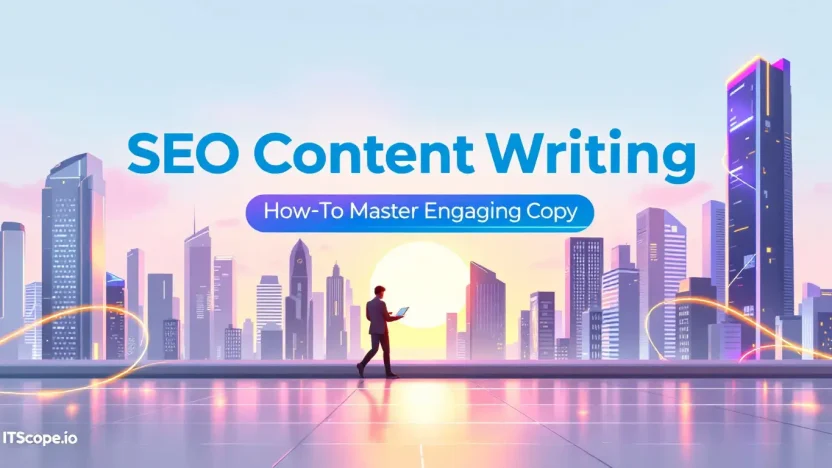In the digital age where competition is fierce, mastering SEO content writing is no longer optional—it’s essential. Whether you’re new to the world of digital marketing or a seasoned professional, understanding how to craft engaging, SEO-optimized copy can be the key to unlocking greater visibility and success online.
Why is this important, you ask? Search engines like Google reward content that not only answers user queries but also engages them, keeping them on the page longer. This guide will demystify the art of SEO content writing and help you transform your words into powerful tools for online growth.
Intrigued yet? Let’s delve into the core strategies that will make your content creation process seamless and impactful. Dive into our comprehensive roadmap below!
Table of Contents
- Understanding the Basics of SEO Content Writing
- Keyword Research: Finding What Your Audience is Searching For
- Crafting Engaging Headlines and Meta Descriptions
- Structuring Your Content for Maximum Impact
- Utilizing LSI Keywords to Enhance Content Relevancy
- Optimizing Images and Multimedia for SEO
- FAQs
- Conclusion: Measuring the Success of Your SEO Content
Understanding the Basics of SEO Content Writing
Imagine being adept at crafting content that not only speaks to your audience but also catches search engines’ attention. That’s the magic of SEO content writing. At its core, it’s about blending creativity with strategic keyword use to boost your digital visibility.
What is SEO Content Writing?
SEO content writing involves creating content with the primary goal of ranking better in search engines. It requires skillful integration of keywords while maintaining readability and relevance for users. Successful seo writing ensures your content is both engaging and optimized.
Key Elements of Effective SEO Content Writing
- Keyword Research: Begin with comprehensive keyword research. Tools like HubSpot provide insights into what terms your audience searches. Learn more about this process in our guide.
- Content Structure: Organize your content with clear headings and bullet points. This boosts readability and signals importance to search engines.
- Quality and Relevance: Write content that directly answers users’ queries. Ensure it’s informative and credible, enhancing engagement.
- Internal Linking: Strategically place internal links to related topics such as our SEO and Content Marketing guide to keep readers engaged.
Integrating seo writing principles fundamentally changes how users find and engage with your content.
By mastering these basics, you’ll be on your way to crafting compelling, seo content writing that resonates and ranks.
Keyword Research: Finding What Your Audience is Searching For
Mastering seo content writing begins with understanding your audience’s search intent. The key is in knowing precisely what terms they enter into search engines. Here’s how you can efficiently nail down which keywords to target.
- Start with Brainstorming: List down topics relevant to your niche. Consider what questions your audience might have or problems they want to solve.
- Use Keyword Tools: Platforms like WordStream offer insights into search volume and competition level for various terms.
- Analyze Competitors: Review your competitors’ content to identify keywords they rank for. This strategic move provides a roadmap that aligns with effective SEO writing strategies.
- Check Search Trends: Google Trends helps track the popularity of keywords over time, allowing you to capitalize on current trends.
- Refine Your List: Focus on relevant and attainable keywords, emphasizing low competition but high relevance terms to optimize your seo content writing tips.
With effective keyword research, your content will resonate better and meet your readers’ expectations, embarking you on a journey to SEO success. For a broader exploration of skills in digital marketing, check out our SEO and Content Marketing guide for mastering digital success.
Using the right keywords can significantly boost your visibility and engagement.
Crafting Engaging Headlines and Meta Descriptions
Effective seo writing starts with the right headline. Why? A catchy headline entices readers while boosting search engine rankings. Here’s how you can master this art.
- Use Power Words: Words like ‘discover’, ‘ultimate’, or ‘free’ make your headline stand out. Make each word count, evoking curiosity or urgency.
- Incorporate Keywords: Naturally include the focus keyword ‘seo content writing’. This ensures your content is SEO-optimized and visible.
- Create a Compelling Meta Description: In under 160 characters, convey why someone should click. Phrases like ‘learn more’ or ‘find out how’ can increase clicks, pushing your SEO and Content Marketing effectiveness.
Key benefit: A top-notch headline and meta description improve click-through rates dramatically.
Quick Tip: Keep headlines under 60 characters for best results. Check out this guide on keyword research to enhance your strategy.
Headlines that Capture Attention
Think of your headline as a fishing hook. It must be sharp and alluring. Experiment by combining numerical inferences with benefits, like ‘5 Tips for Mastering SEO Writing’.
Structuring Your Content for Maximum Impact
Creating SEO content writing that captivates your audience is essential for boosting online visibility. The right content structure ensures your message hits home, engages readers, and enhances your search engine rankings. Follow these steps to master your SEO content writing structure.
- Start with Keyword Research: Action-packed content begins with strong keyword research. Include primary and secondary keywords naturally. This boosts your chances of appearing in front of potential readers.
- Craft an Enticing Introduction: Hook your audience immediately. Use engaging storytelling or a thought-provoking question to spark interest. Ensure you incorporate keywords early on to signal relevance.
- Use Headings and Subheadings: Structure your content with clear headings that guide readers smoothly through your content journey. By breaking up text, you make it more digestible and easier to scan.
- Incorporate Visual Elements: Introduce images, bullet points, or blockquotes to maintain reader engagement. These elements simplify complex ideas and highlight essential points.
- Include Internal and External Links: Linking to relevant internal pages, like SEO and Content Marketing: The Ultimate Guide to Mastering Digital Success, boosts your site authority. Outbound links to authoritative sources enhance credibility.
Conclusion
By mastering SEO content writing, focusing on effective structure, and optimizing for search engines, your content will reach a wider audience and drive more traffic. Structure isn’t just about aesthetics; it’s about crafting a seamless reading experience that resonates with your audience and search engines alike. For more on achieving content excellence, explore SEO writing strategies.
Utilizing LSI Keywords to Enhance Content Relevancy
Ever wonder how SEO content writing can reach its full potential? Leveraging LSI keywords is a game-changer! These are words or phrases semantically related to your focus keyword that help search engines understand your content better, boosting its relevancy.
- Identify Appropriate LSI Keywords: Tools like WordStream can help. By exploring these terms, you can diversify your content and keep it engaging.
- Incorporate Naturally: Ensure these keywords fit seamlessly into your narrative. Forced placements can harm readability and SEO.
- Monitor Keyword Density: Striking the right balance is crucial. Overstuffing can be detrimental, so aim for natural, quality-packed content.
For a deeper dive into optimizing your digital success, check out our guide on SEO and Content Marketing.
Enhancing relevancy with LSI keywords improves search rankings and reader engagement.
Explore additional resources on keyword research to further refine your skills in SEO writing.
Optimizing Images and Multimedia for SEO
Wondering how to boost your SEO content writing? Images are powerful tools. Let’s explore how to optimize them to enhance your visibility.
- Use Descriptive Filenames: Before uploading, rename image files with relevant keywords like seo-writing-guide.jpg instead of IMG123.jpg.
- Add Alt Text: Describe your images with SEO-friendly keywords to improve accessibility and search engine understanding.
- Optimize Image Size: Compress images to maintain quality while boosting load speed, which directly impacts user engagement and search rankings.
- Leverage Captions and Titles: Use them strategically as part of your seo writing to wrap readers into your narrative.
- Include Multimedia Metadata: Include keyword-rich metadata for video and audio files, enhancing SEO effectiveness.
Learn more about boosting your content prowess by visiting our guide on SEO and Content Marketing.
Key benefit of using seo content writing: Effective multimedia optimization enhances both user engagement and SEO.
FAQs
What is SEO content writing?
SEO content writing is the technique of producing content that attracts search engines while engaging readers. It involves using strategic keywords and crafting high-quality content that’s informative and valuable. Learn more about these techniques in our SEO and Content Marketing Guide.
How do you optimize content for SEO?
To optimize content for SEO, incorporate keywords naturally, use headings and subheadings, and include internal and external links. Discover additional tips for optimizing your content through comprehensive keyword research.
What are some SEO content writing tips?
Some effective SEO content writing tips include writing for your audience first, maintaining clarity, leveraging secondary keywords, and updating content regularly. Check out Rock Content’s guide for more advice.
Why is keyword research important in SEO writing?
Keyword research is critical in SEO writing as it helps you understand what your audience is searching for. This insight enables you to create relevant content that naturally resonates with your target audience. For more information, visit HubSpot’s keyword research guide.
What is the best way to include keywords?
The best way to include keywords in your content is to use them naturally and strategically in the title, headings, and throughout the content. Ensure they fit seamlessly without disrupting the reader’s experience.
Conclusion: Measuring the Success of Your SEO Content
How do you know if your seo content writing efforts are paying off? Successful SEO content isn’t just about crafting engaging copy. It’s also about monitoring key metrics to evaluate performance. Here are some practical steps to measure your success:
- Track Keyword Rankings: Regularly check how your focus and secondary keywords are ranking on search engines.
- Monitor Organic Traffic: Use tools like Google Analytics to see how much of your traffic comes from organic search.
- Analyze User Engagement: Look at metrics like bounce rate and time on page to gauge reader engagement.
- Measure Conversion Rates: Are readers taking action? Track conversions to assess digital success efforts.
Pro Tip: Regular performance reviews help refine your SEO content writing strategy for continuous improvement.
By understanding these metrics, you can adjust your SEO writing strategies to improve site performance and reach your audience effectively.



